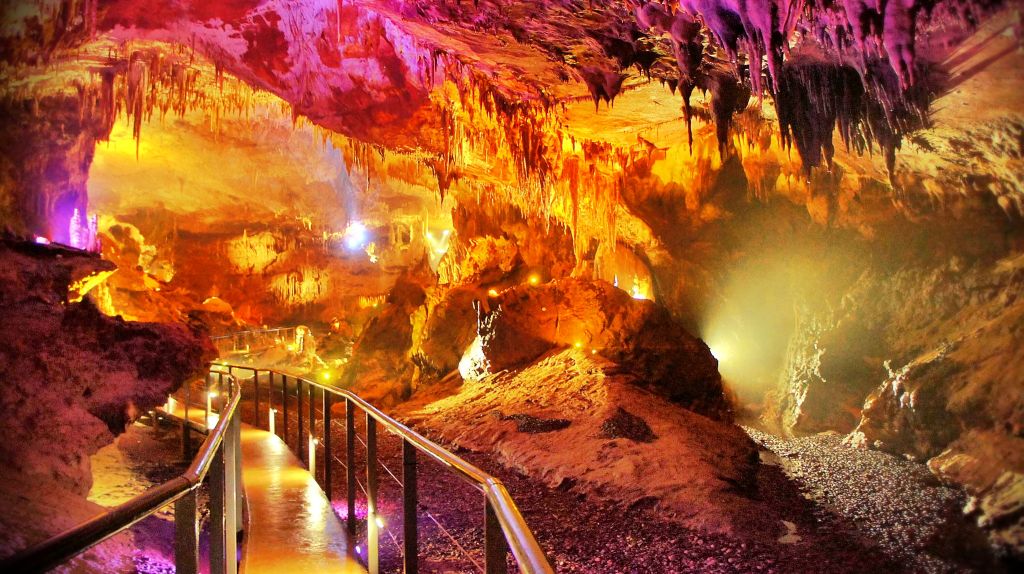Trip starts at 8:00
Price 90 Gel per person, Individual 450Gel (1-5person)
Visit places: Kutaisi
Sataplia cave
Prometheus cave
Bagrati Cathedral
Kutaisi (Georgian: ქუთაისი [kutɑisi]; ancient names: Aea/Aia, Kotais, Kutatisi, Kutaïsi) is the legislative capital of Georgia, and its 3rd most populous city. Situated 221 kilometres (137 miles) west of Tbilisi, it is the capital of the western region of Imereti.Kutaisi is surrounded by deciduous forests to the northeast and the northwest. The low-lying outskirts of the city have a largely agricultural landscape. The city centre has many gardens and its streets are lined with high, leafy trees. In the springtime, when the snow starts to melt in the nearby mountains, the storming Rioni River in the middle of the city is heard far beyond its banks.
Kutaisi was the capital of the ancient Kingdom of Colchis. Archaeological evidence indicates that the city functioned as the capital of the kingdom of Colchis in the sixth to fifth centuries BC.[3] Several historians[who?] believe that, in Argonautica, a Greek epic poem about Jason and the Argonauts and their journey to Colchis, author Apollonius Rhodius considered Kutaisi their final destination as well as the residence of King Aeëtes. From 978 to 1122 CE, Kutaisi was the capital of the united Kingdom of Georgia, and from the 15th century until 1810, it was the capital of the Imeretian Kingdom. In 1508, the city was conquered by Selim I, who was the son of Bayezid II, the sultan of the Ottoman Empire. During the seventeenth century, Imeretian kings made many appeals to Russia to help them in their struggle for independence from the Ottomans. All these appeals were ignored as Russia did not want to spoil relations with Turkey. Only in the reign of Catherine the Great, in 1768, were troops of general Gottlieb Heinrich Totleben sent to join the forces of King Heraclius II of Georgia, who hoped to reconquer the Ottoman-held southern Georgian lands, with Russian help. Totleben helped King Solomon I of Imereti to recover his capital, Kutaisi, on August 6, 1770.
The Sataplia Nature Reserve is located in Tskaltubo district, about 260 km. from Tbilisi. Established in 1935 to protect the Sataplia Cave and dinosaur footprints found in the area, this visitor attraction recently benefited from a very attractive refurbishment of its Sataplia Cave visitor center. Sataplia Cave is named after Sataplia Mountain, which gained its name from the local tradition of collecting honey from the bees that inhabit the mountain’s southern slope. Sataplia means ‘place of honey’. A Conservation Center and Museum have been constructed, together with glass walkways, viewing points, a cafeteria and other visitor amenities.
Prometheus Cave
Discovered in Imereti region in 1984, Prometheus Cave is one of Georgia’s natural wonders providing visitors with breathtaking examples of stalactites, stalagmites, curtains, petrified waterfalls, cave pearls, underground rivers, and lakes. Khvamli Mountain is visible from Prometheus Cave and is the place where legend says that Prometheus was chained. The 1060 meter walking route through the cave was upgraded in the summer of 2012 and visitors can also enjoy a 280 meter boat tour on an underground river.Bagrati Cathedral
Bagrati Cathedral was built in the early years of the 11th century, during the reign of King Bagrat III, due to which it was called “Bagrati”, i.e., Bagrat’s cathedral. An inscription on the north wall reveals that the floor was laid in “chronicon 223”, i.e., 1003. In 1692, it was devastated in an explosion by Ottoman troops who had invaded the Kingdom of Imereti. The incident caused the cupola and ceiling to collapse. Conservation and restoration works, as well as archaeological studies at the Cathedral began in the 1950s under the leadership of a Georgian architect Vakhtang Tsintsadze. The restoration works headed by Tsintsadze were divided into six stages and continued for several decades through 1994. That same year in 1994 Bagrati Cathedral, together with the Gelati Monastery, was included in UNESCO’s World Heritage Site list as a single entity. In 2001, ownership of the cathedral was transferred from the Georgian state to the Georgian Orthodox Church. It is presently of limited use for religious services, but attracts many pilgrims and tourists. It is also frequently used as a symbol of the city of Kutaisi, being one of its main tourist attractions.
The Cathedral of the Dormition, or the Kutaisi Cathedral, more commonly known as Bagrati Cathedral, is an 11th-century cathedral in the city of Kutaisi, in the Imereti region of Georgia. A masterpiece of the medieval Georgian architecture, the cathedral suffered heavy damage throughout centuries and was reconstructed to its present state through a gradual process starting in the 1950s, with major conservation works concluding in 2012. A distinct landmark in the scenery of central Kutaisi, the cathedral rests on the Ukimerioni Hill.



 Geo
Geo Eng
Eng Rus
Rus













 24/01/2018
24/01/2018
 +995 555 98 51 51
+995 555 98 51 51

